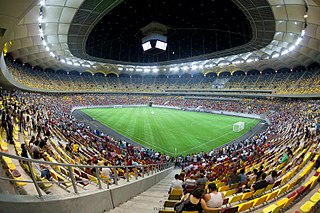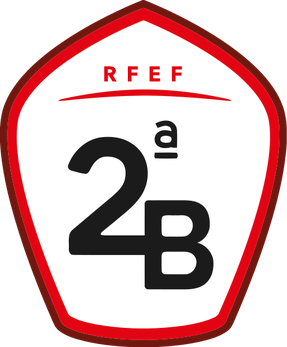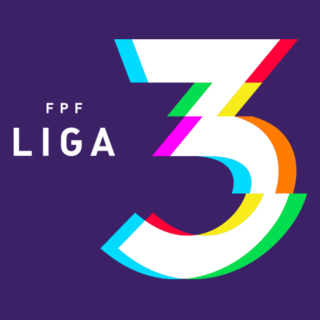The playoffs, play-offs, postseason or finals of a sports league are a competition played after the regular season by the top competitors to determine the league champion or a similar accolade. Depending on the league, the playoffs may be either a single game, a series of games, or a tournament, and may use a single-elimination system or one of several other different playoff formats. Playoff, in regard to international fixtures, is to qualify or progress to the next round of a competition or tournament.
The Liga Portugal 2, also known as Liga Portugal SABSEG for sponsorship reasons, is the second-highest division of the Portuguese football league system. At the end of each season, the two top-finishing teams are promoted to the top-tier Liga Portugal and the two lowest-ranked teams are relegated to the third-tier league. Starting with the 2021–22 season, relegated teams will no longer compete in the Campeonato de Portugal, which will become the fourth tier, but in a newly created third-level competition named Liga 3.

The Apertura[apeɾˈtuɾa] and Clausura[klawˈsuɾa] tournaments is a split season format for Spanish-speaking sports leagues. It is a relatively recent innovation for many Latin American football leagues in which the traditional association football season from August to May is divided in two sections per season, each with its own champion. Apertura and Clausura are the Spanish words for "opening" and "closing". In French-speaking Haiti, these are known as the Ouverture and the Fermeture, while in English-speaking Belize, they are respectively the Opening and Closing seasons. When used in the United States and Canada, they are known as the Spring and Fall seasons.

The Peru First Division, officially known as Liga 1, is the top flight of association football in Peru. It has been referred to as Torneo Descentralizado since 1966, when the first teams residing outside the Lima and Callao provinces were invited to compete in the inaugural league national competition.

Liga Leumit is the second division of the Israeli Football League, and below its Premier League.
The Mexican football league system is organized by the Mexican Football Federation, except for the Liga MX and the Ascenso MX that are organized independently; The tournaments consist of five levels, male and female professional levels. In addition to having the Copa MX which is also organized independently to the Femexfut.

The Liga Națională Baschet de Masculin (LNBM) is the top-tier professional basketball league of Romania. The winner of the league each season is crowned the Romanian national champion. Founded in 1950, the league consists of 24 teams playing in three different divisions. Currently, the clubs from the Liga Națională also participate in the European competitions, and can qualify for the Basketball Champions League or the FIBA Europe Cup based on their performance in the national league and cup competition. The most successful club in the league's history is Dinamo București, who has won a record 22 titles. Asesoft Ploieşti won the championship seven times in a row between 2004 and 2010, and again between 2012 and 2014. They became the only Romanian team to win a European title with their success in the FIBA EuroCup Challenge in 2005.

Football is the most popular sport in Romania. The Romanian Football Federation, a member of UEFA, is the sport's national governing body.

The J2 League or simply J2 is the second division of the Japan Professional Football League and the second level of the Japanese association football league system. The top tier is represented by the J1 League. It is currently sponsored by Meiji Yasuda Life and it is thus officially known as the Meiji Yasuda J2 League. Until the 2014 season it was named the J.League Division 2.
The Ekstraliga is the top Polish league for women's association football teams.

The Liga I is the top level women's football league in Romania. The champion team qualifies for UEFA Women's Champions League.
The 2010–11 Campeonato Nacional de Fútbol de Cuba was the 100th season of the highest division of Cuban football, and the first season under its present format.
The 2015–16 Primera Divisió or Lliga Grup Becier, was the 21st season of top-tier football in Andorra. The season began on 27 September 2015. The defending champions were FC Santa Coloma, who won their ninth championship in the previous season.

The Challenger Pro League is the second-highest division in the Belgian football league system, one level below the Belgian Pro League. It was created by the Royal Belgian Football Association in 2016, replacing the Belgian Second Division. From the season 2016–17 until 2019–20, the competition was named Proximus League, after the main sponsor Proximus.
The La Liga play-offs are an annual series of football matches to determine the final promotion places within Segunda División and La Liga. In its current format, it involves the four teams that finish directly below the automatic promotion places from Segunda División to the top tier. These teams meet in a series of play-off matches to determine the final team that will be promoted. Reserve teams are not eligible for promotion.
The 2020–21 Liga I was the 103rd season of the Liga I, the top professional league for Romanian association football clubs. The season started on 21 August 2020 and ended on 19 May 2021. CFR Cluj were winners and three-time defending champions. It was the sixth season to take place in the play-off/play-out format, and the first since the 2005–06 season to feature 16 teams.

Segunda División B was the third tier of the Spanish football league system containing 102 teams divided into five groups, until it was replaced by the new structure in 2021. It was administered by the Royal Spanish Football Federation. It was below the top two professional leagues, the Primera División and the Segunda División, and above the Tercera División. The Segunda División B included the reserve teams of a number of La Liga and Segunda División teams.

The Liga 3 is the third-level football league in the Portuguese football league system, starting in 2021–22. It is a professional national league organized by the Portuguese Football Federation (FPF).
The 2021–22 Liga I was the 32nd season of the top level women's football league of the Romanian football league system. 12 teams played a one legged-round robin. The top 6 teams progressed then to the play-offs, while the bottom 6 teams to the play-out, where a two-legged round-robin took place. Teams ranked 11 and 12 would relegate directly to the 2022–23 Liga II.









